Amelia Flight Of Fancy 70 Years Later
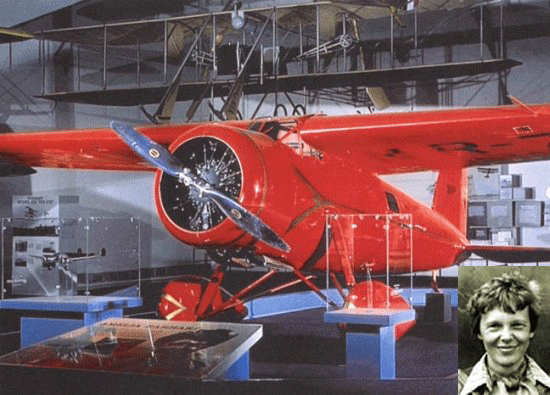
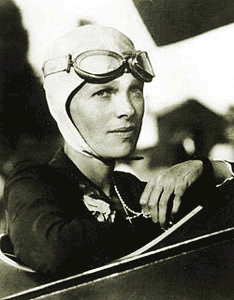 Although
she disappeared somewhere in the Pacific Ocean July 2 1937, seventy
years ago this summer, Amelia Earhart has remained the most famous,
if not favorite, female aviator in history.
Although
she disappeared somewhere in the Pacific Ocean July 2 1937, seventy
years ago this summer, Amelia Earhart has remained the most famous,
if not favorite, female aviator in history.
Indication of that is, earlier this year
USA Secretary of the Navy Donald Winter named the newest underway replenishment
vessel, USNS Amelia Earhart (T-AKE 6).
Amelia Earhart's name became a household
word in 1932 when she became the first woman—and second person—to
fly solo across the Atlantic, on the fifth anniversary of Charles Lindbergh's
feat, flying her blood red Lockheed Vega from Harbor Grace, Newfoundland
to Londonderry, Ireland.
That year, she received the Distinguished
Flying Cross from the Congress, (the first ever given to a woman), the
Cross of Knight of the Legion of Honor from the French government, and
the Gold Medal of the National Geographic Society from President Herbert
Hoover.
But backing up a moment, credit the great
aerial pioneer pilot Frank Hawks who on December 20,1928 gave her a
ride that would forever change her life. “By the time I had got
two or three hundred feet off the ground,” she said, “I
knew I had to fly.”
Later with Publisher George Putnam who
she developed a friendship with and married, she prepared to make a
solo flight across the Atlantic On May 20, 1932, she started the trek
from Harbor Grace, Newfoundland, to Paris.
Strong north winds, icy conditions and
mechanical problems plagued the flight and forced her to land in a pasture
near Londonderry, Ireland.
“After scaring most of the cows
in the neighborhood,” she said, “I pulled up in a farmer's
back yard.”
Ms. Earhart for her part felt the flight
proved that men and women were equal in “jobs requiring intelligence,
coordination, speed, coolness and willpower.”
In the years that followed, Amelia Earhart
continued to break records.
On January 11, 1935, she became the first
person to fly solo across the Pacific from Honolulu to Oakland, California.
Chilled during the 2,408-mile flight, she unpacked a thermos of hot
chocolate. "Indeed," she said, "that was the most interesting
cup of chocolate I have ever had, sitting up eight thousand feet over
the middle of the Pacific Ocean, quite alone."
Later that year she was the first to solo
from Mexico City to Newark.
A large crowd "overflowed the field,"
and rushed Earhart's plane.
"I was rescued from my plane by husky
policemen," she said, "one of whom in the ensuing melee took
possession of my right arm and another of my left leg."
The officers headed for a police car,
but chose different routes.
"The arm-holder started to go one
way, while he who clasped my leg set out in the opposite direction.”
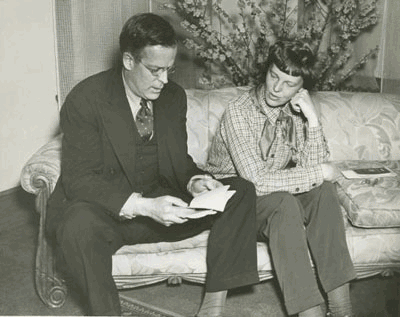 In
1937, as Earhart neared her 40th birthday, she was ready for a monumental,
and final, challenge.
In
1937, as Earhart neared her 40th birthday, she was ready for a monumental,
and final, challenge.
She wanted to be the first woman to fly
around the world.
"I have a feeling that there is just
about one more good flight left in my system, and I hope this trip is
it," she said.
On June 1st, Earhart and her navigator
Fred Noonan departed from Miami and began the 29,000-mile journey.
By June 29, when they landed in Lae, New
Guinea, all but 7,000 miles had been completed.
Frequently inaccurate maps had made navigation
difficult for Noonan, and their next hop—to Howland Island—was
by far the most challenging.
Located 2,556 miles from Lae in the mid-Pacific,
Howland Island is a mile and a half long and a half-mile wide.
Every unessential item was removed from
the plane to make room for additional fuel, which gave Earhart approximately
274 extra miles.
The U.S. Coast Guard cutter Itasca, their
radio contact, was stationed just offshore.
Three other U.S. ships, ordered to burn
every light on board, were positioned along the flight route as markers.
"Howland is such a small spot in the Pacific that every aid to
locating it must be available," Amelia said.
At 12:30 p.m. on July 2, the pair took
off.
Despite favorable weather reports, they
flew into overcast skies and intermittent rain showers.
This made Noonan's premier method of tracking,
celestial navigation, impossible.
As dawn neared, Amelia Earhart called
chief radioman Leo G. Bellarts and asked for Itasca's location.
She failed to report at the next scheduled
time, and afterward her radio transmissions, irregular through most
of the flight, were faint or interrupted with static.
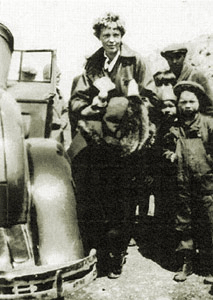
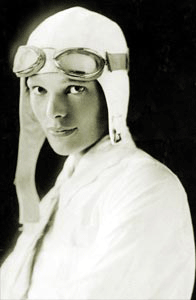
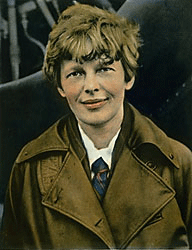 At
7:42 A.M. the Itasca picked up the message,
At
7:42 A.M. the Itasca picked up the message,
"We must be on you, but we cannot
see you.
“Fuel is running low.
“Been unable to reach you by radio.
We are flying at 1,000 feet."
The ship tried to reply, but the plane
seemed not to hear.
At 8:45 Earhart reported:
"We are running north and south."
Nothing further was heard from Earhart.
A rescue attempt commenced immediately and
became the most extensive air and sea search in naval history.
On July 19, after spending $4 million
and scouring 250,000 square miles of ocean, the United States government
reluctantly called off the operation.
In 1938, a lighthouse was constructed
on Howland Island in her memory. Today, though many theories exist,
there is no proof of her fate.
There is no doubt, however, that the world
will always remember Amelia Earhart for her courage, vision, and groundbreaking
achievements, both in aviation and for women.
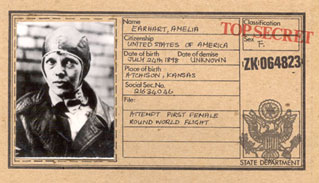 "Please
know I am quite aware of the hazards,” Amelia once said.
"Please
know I am quite aware of the hazards,” Amelia once said.
"I want to do it because I want to
do it. “Women must try to do things as men have tried.
“When they fail, their failure must
be but a challenge to others."
Today for many, she still flies, not a
day older, forever young as part of the legendary and heroic first generation
of flight.
But Amelia Earhart was much more than
flinty pictures in old scrapbooks and yellowed newspaper clippings.
She was the embodiment of the youth and
vitality of the so-called “Golden Age of Flight.”
Amelia Earhart also left a written and
spoken history that is often overlooked but included here in this text
and amongst some of her most famous still pictures.
Brave Amelia Earhart for some will always
be “First Lady Of The Air.”
Geoffrey




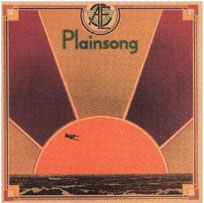 We
were quite taken with a 1972 album by Ian Matthews and Plainsong titled
"The Search For Amelia Earhart."
We
were quite taken with a 1972 album by Ian Matthews and Plainsong titled
"The Search For Amelia Earhart."